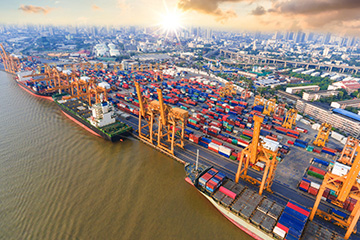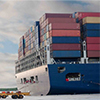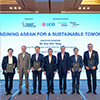About the speaker
Lee Eng Keat is an Executive Director at Group Foreign Direct Investment Advisory, UOB. He is responsible for developing partnerships with government agencies, trade associations and professional service providers. These partnerships support the Bank’s efforts to help companies set up and to grow their operations as they tap opportunities across Asia.
Eng Keat brings more than 20 years’ experience with the Singapore Economic Development Board (EDB) to UOB. During his time at EDB, he developed strategies to engage with global logistics, utility and agrifood companies to drive their investments into Singapore and to position the country as a springboard to the Asia Pacific region.
He graduated from the University of Illinois Urbana-Champaign with a Master’s Degree in Electrical Engineering.
Transcript
Hi everybody, my name is Eng Keat from the UOB FDI Advisory team. I'm glad to have you all here with me today. Today's session is set up to share and (is) targeted at North American companies looking to tap on ASEAN as a target market, as well as Southeast Asia VCs and capitalists that are looking to help their portfolio companies expand in Southeast Asia. For today, I just want to cover a bit about Southeast Asia's market potential and update on the internet economy. And then go a bit into how the UOB Foreign Direct Investment advisory team, as well as The FinLab – my counterparts and colleagues in the FinLab itself – helps companies expand in Southeast Asia. So without further ado, let me step into the slides.
This is the agenda for today. Let me not prolong it, but really just dive straight into it, regarding why Southeast Asia is an attractive market for tech players.
But first, let me explain a bit about where Southeast Asia is because interestingly, we have heard of many stories – maybe a few stories here and there, where they may put a letter addressed to Singapore, but then they will put comma, China, down there as well. And sometimes this letter is really just an indication of how perhaps up in North America, Southeast Asia is a much less known geography itself. So if you see the countries embedded in red, highlighted in red, these are the countries that make up Southeast Asia. And I think an interesting note to kind of keep in mind, if you look at the breadth of Indonesia, itself, that spans the same geographical width as the United States of America. The main part of it which is out from the east coast and the west coast. So you kind of get a sense of how wide and the geography that we are really talking about here in Southeast Asia.
The key markets, our focus today, really is those highlighted in red. There will be less emphasis on Brunei because it's a relatively smaller country. Nonetheless, UOB has a certain presence there too.
Now, let's dive straight into the content. If you look at the recent news, RCEP was recently announced—the Regional Comprehensive Economic Partnership—and that portends well to the growth of the region. (ASEAN) is currently the fifth largest economy in the world, and is expected to be the fourth largest economy by 2030. And this is largely driven by two broad trends which are common to many emerging markets: one, which is a growing consumer market itself. And the second is really an export orientation towards exporting goods, not only towards Asia, but to the rest of the world. Let me elaborate in the next few slides.
So if you look at it, the GDP in Southeast Asia, the few countries that we've highlighted earlier two slides ago, has actually doubled its GDP (the gross domestic product) over the last 10 years or so, see 2008 to 2018. And it’s further expected to again double up to 2030 to $6.6 trillion. One of the key factors in these very externally-oriented markets, trade has increased greatly, as far as you can see on the table on the right. And I think the general sense of signing further treaties, opening up markets and contributing to global value chains will continue to be key features within Southeast Asia itself.
It's supported by a growing population numbers that has just seen the good growth, the population growth rates, the fertility rates vary across the different Southeast Asian countries. The fastest growing will obviously be some of the key countries like Vietnam, Myanmar as well as Indonesia, which are still emerging and growing. But then for the developed cities, more towards Singapore, fertility rates will reach European late rates. And Thailand is slowly but surely creeping there, towards there as well. So there is also a bit of a varying population group as well.
And the middle income with the rise of GDP, with the rise of trade has also been steadily growing. And you can see almost a tripling of the middle income numbers as indicated in those numbers itself. We have estimated that this is a growing consumer market that companies are increasingly interested to target, especially with the advent and the emergence of the internet economy driven by COVID-19.
Perhaps a preface to that is that internet access has steadily improved. And to address the needs of the internet savvy population, Google, Temasek & Bain’s study from 2015 to 2019 observed that they added 100 million internet users. But just this year alone, it probably added something like 40 million. And 70 per cent of the region's population is now online, aided by the growth of mobile internet infrastructure growth in the region itself. And the cost of much of the mobile internet plans are actually very low and affordable to target the growing middle income.
Really, COVID-19 has accelerated the growth of the digital economy. Many of the SMEs in the region itself was facing a ‘digitalise or perish’ orientation. Businesses couldn't get on board, you couldn't travel, there were severe movement control orders, restrictions on movements. And gradually but surely, especially here in Singapore itself, it's been observed that the SMEs have been slowly trying to get on board as much as they can, with support from the various government institutions as well. And if you are familiar with the Singapore environment, where some of the food centres in Singapore are really low key places, the advancement as well as introduction of digital payments, and then subsequently food delivery, has really enabled them to thrive and survive, through this whole pandemic itself. We've seen consumers also accelerate the acceptance of the adoption. The Google, Temasek & Bain study actually observed that about 36 per cent of the consumers were new to digital service. But I think overall it has caught on very quickly. I mean, Asia and ASEAN in particular tends to be fairly mobile-savvy. Friends who come alongside I guess family members who support the adoption. And the sense is that because they've now discovered a newer way to undertake transactions and interact with the services, about 94 per cent of these new users will stay and it just accelerates the growth of the so-called ASEAN internet economy.
So with that in mind, what are the key areas the study itself looked into things like online media, online travel, transport, food and e-commerce. And if you dive a bit deeper into it, this year 2020 with COVID-19, online travel has really suffered significantly. And to a certain extent, transport, especially shared transport itself has declined somewhat. But the rise of e-commerce as well as online media has more than overcome the declines that we have seen in online travel itself. I think a lot more people are spending time at home consuming digital media, using I guess, the streaming services as new forms of entertainment. And of course, as going about becomes more restrictive, then transportation, food delivery has increased. And we have of course, observed the explosion in e-commerce over the course of this year itself. And there is no turning back. The interesting observation is that there are new services that's being introduced as well. We believe that healthtech has reached a certain transition. I think doctors, users themselves, has grown a bit more familiar and perhaps more open. And then the regulations will have to catch on in order to see how best to address the new awareness of healthcare users, especially for those who are located in secondary cities, which are further away from city centres. And the other area is EduTech. And with schools closed, there was greater inclinations as well as openness to explore, what does the internet have to offer in terms of long-distance education options for the consumers and the children at home as well. So we believe that over the next five years the growth will continue to accelerate which portends well I think, for many of the internet companies trying to understand and identify new growth markets in Asia.
But the growth is not restricted just to consumers. I think here in UOB itself, we also feel very strongly that the overall advancements in manufacturing will continue to grow. We have observed and heard from the likes of Thailand, Malaysia, Vietnam governments very keen to understand what are the new internet 4.0 Industries. They recognise and they understand that they do need to enable more sophisticated manufacturing solutions as well as processes. And I think the development of systems sensors that really is lower cost in adoption. And I see most solutions out there with proof of concepts with clear returns on investment over a shorter timeframe to encourage companies to undertake some of these advanced manufacturing activities as well.
And then last but not least, in terms of the opportunities in ASEAN, in terms of the digital growth and internet growth, it's really a whole new understanding of how we can build more sustainable cities in ASEAN itself. And if you keep in mind that much of the growth in ASEAN is going to be driven by many of the key cities in ASEAN itself: cities like Jakarta, of course, KL (Kuala Lumpur), Bangkok, the key cities itself. But then there are very sizable secondary cities in Medan, in Surabaya, Ho Chi Minh City of course, going through strong growth as well. And then of course, you can keep up with Mandalay and in Malaysia itself, you want to observe the things happening out on the East Malaysia side of things, of course, besides Johor and Penang. So all these this might be unfamiliar names, especially to our North American attendees. But really, when it comes down to city growth itself, this is where most of it, the middleweight cities have been observed by the ASEAN Smart Cities framework concept known to drive about 40 per cent, actually, of the region's growth.
So with that in mind, because of the diversity that you have in Southeast Asia, I just wanted to then lend a bit of initial suggestion on, perhaps if you are B2C companies and more consumer-oriented, which countries to focus on. One of the benchmark we use is actually household consumption as a percentage of GDP, of which Philippines as well as Vietnam, fares very well. And Indonesia, just because of its sheer size of its population, although relatively household consumption is relatively- it's a bit lower. But because of the large population size, it's also a country that you do want to take note. And the advantage of Indonesia is much of that population is actually located in the main island of Java, which then makes it relatively easier to engage.
On the B2B front, if you're looking at more export-oriented ASEAN markets, with manufacturing activities, and if your solutions are really targeting those kinds of sectors: Singapore, Malaysia, Vietnam and Thailand are the key markets that you would look out for. But really, when it comes down to growth in these countries itself, they recognise that manufacturing is a key sector that they do want to promote. And therefore they are also very keen and active in terms of being open to B2B, new solutions, industry 4.0 solutions that are emerging, as well. As we speak, we are currently working with the various investment promotion agencies to see whether we can get together SMEs in—manufacturing SMEs, from some of these markets, to attend webinars, to expose them to how to embark on a digitalisation journey on their manufacturing activities itself. So, news to be shared a bit later on as we broadcast about activities that we're doing in the region.
So I hope that kind of paints you a promising sense of the growth and the promise that ASEAN has. Be it if you are a consumer-oriented company, or a business, or a manufacturing technical-oriented company itself. But I think the understanding of ASEAN itself is that it has its own challenges and it's not a straightforward market to engage. There are various non-tariff barriers that are pretty significant, which we continue to try to overcome. The RCEP was indeed a very good development for us because we do want to change and make it more easy in terms of the rules of origin and make goods flow between the different countries in North Asia and ASEAN itself and therefore, global value chains in order to target global products and needs. And the good thing is that with RCEP, about more than 90 per cent of trade tariffs have been eliminated. And there is room there to grow the connectivity in the region. The other key note is that the infrastructure developments in ASEAN is still a work in progress. And you may come into Singapore, and then you experience a certain level of quality of infrastructure. And then there, however, still needs quite a bit of infrastructure development in key countries like Vietnam, in the secondary cities out in Indonesia, as well as perhaps at places like Myanmar itself. And with that in mind, that's why the project financing needs in the region continues to grow fairly significantly. And in order to connect the secondary cities, the middleweight cities that we talked about earlier on, the infrastructure investments are also needed. But a challenge might also be translated to opportunities. And that's why we see ASEAN and especially some of the newer emerging cities, big cities like Bandung really has the opportunity to leapfrog by rolling out some of the newer infrastructure requirements to support the growth of the internet economy itself. Last but not least, if you think about how ASEAN is almost the size—geographical size—of the main part of the US, the East Coast and West Coast itself, it has his own range of cultures and language barriers as well. And so therefore, there is that sensitivity and understanding or localised approach regarding targeting these markets.
Last but not least, the ease of doing business varies across the region. And I’ll just let the ranking speak for itself. And if you think about a broad way of categorising it, the larger consumer markets, countries like Indonesia and Vietnam, tends to be a bit more careful in regards to opening up the markets, and they are also emerging from that perspective. And so therefore, they are, I guess, has more regulations. The good thing is that they are all heading in the right direction. Indonesia just introduced an omnibus law that is going to (be) one of the key areas and is going to free up as well as facilitate the ease of managing labour in Indonesia itself. Vietnam, as we have signed an MOU recently with them, also talks about how they will make themselves much more attractive and ease of doing business is a key thing to address as well. For those who are familiar with ASEAN – Thailand, Malaysia, Singapore continues to understand that ease of doing business is going to be key areas to focus on even as they focus on attracting investments in order to drive the growth of the economy.
So with that in mind, I do want to transition then to the next set of slides itself that will share with you about UOB’s extensive network and how we can support your expansion in the region.
So firstly, I like to think about UOB as a bank that has an unrivalled platform in ASEAN itself. If you look at the branch network, I would safely say that, especially in places like Indonesia, Malaysia, and Thailand, we will be the largest foreign bank in those regions, and one of the largest foreign banks. And it is this branch network itself, and the deep roots and the understanding and long history of operating in ASEAN that really allows us to understand the markets and support you in your growth in the region.
And with that in mind, then how do we work with you? There are two particular units that I will talk about in today's presentation, that we can then discuss about how we support your growth and market entry. One of it is the unit that I’m from, the FDI Advisory unit. And really, for this group, what we are targeting are really (in the past) SMEs, about 30 million (SGD) revenue and above. But with the recent trend and growth of the internet economy, companies are so fast growing. We realised that these are the SMEs of the future. And so with that in mind, we are looking to also then serve the Series B and above companies with a product that's already receiving some cash flows, tried a bit, tried and tested and are looking for new markets. So we believe that such companies have the right capacity and the right time to help them expand in Southeast Asia itself.
So with that, the unit consists of a team that is located in the 10 FDI centres that you can see down here. And what we have is then boots on the ground. We believe that if we can advise you, in setting up your company, support you in connecting with the various government agencies, chambers of commerce in the various parts of the world, and help you settle down in the country, so it's a pro bono service that we render. We will then build a strategic relationship with you in order to serve you and support you in your financial services later. So it’s this kind of a long-term strategic business relationship building mindset that we hope and will set up the unit itself, in order to work with you on expanding. The local FDI advisors are then able to help you understand the insights and then connect you with the market. We understand the local lawyers, who are players who can help you unlock or setup, facilitate the hiring of people, and also register your companies in those countries itself. And then particularly because of China's strong growth in the region (Southeast Asia region), we've also set up dedicated China desks in these countries that you see down there in order to support the expansion as well.
So with that in mind, this is an example of the various partnerships; you can see that it is fairly extensive. And it not only ends off at these areas, we use them to understand who are the VCs, who are the SMEs, the players that are more open to innovation, what are the innovation centres around that is perhaps more active, and therefore, potential receptacles and partners for you as you try and expand your market entry. Oftentimes, we will also identify the US chambers that will be there, the Canadian, the North American chambers, as well as the Euro chambers, and then work with some of the local associations. And an example of how we have been able to grow these relationships is how we’ve extended a new MoU with Vietnam. And we understand that sometimes registering a company within Vietnam itself has its own challenges. There are various requirements where you have to get the documents in local language and notarised by the respective representatives even overseas as well. So with that, we therefore signed a MoU with the foreign investment agency in Vietnam, to keep close touch and develop a relationship so that if you are a UOB client, we can then work with them to identify what are the potential challenges and see how best to facilitate your investment application licences in Vietnam itself. And as you think about how best and where to set up in Vietnam, there are, set up within the country, Investment Promotion centres in North, South and Central Vietnam. And that's where, again, they support the local engagements and engaging the local regulatory authorities that can help in facilitating the growth as well as the engagement of the companies—the regulatory authorities—in this part of Vietnam itself. And so if we think about that strategic relationship, we've extended it to Malaysia, Myanmar, Indonesia and Singapore as well, in order to facilitate your market entry.
So let me transition because if you are still relatively new and emerging, but you have a solution that is very suitable for SMEs, especially in the region, then my colleagues in The FinLab may actually be that the appropriate partner for you to enter, because they have a much more broad-based approach.
They started off actually as a FinTech accelerator. But as they engaged the companies and the solution players in the region, they recognised how SMEs in the region still require quite a bit of hand holding, so that they are able to even think and consider starting on a digitalisation journey. So instead of focusing on the solutions providers, The FinLab started to engage the SMEs in Singapore, Malaysia and Thailand, and started to organise workshops to help business owners understand basic concepts like agile thinking, using data and how to extract and clean up your data, and use data to drive and identify key opportunities, and subsequently, identify what are the key low-hanging fruit for deployment of digital solutions. And I think it has been this journey that The FinLab has been able to better match-make tech solutions with the businesses that are ready. And oftentimes, that's some of the feedback that we get, that the tech solutions appreciate the fact that The FinLab has been able to help companies bring them to a point where they are ready to adopt some of these solutions. Otherwise, many of the tech solutions actually give us feedback that oftentimes the tech solutions are educating the businesses and really are not really at the stage towards implementation. And it has been this journey that's really encouraged The FinLab, to undertake close engagements with the various government agencies in Singapore, Malaysia and Thailand, to identify groups of SMEs that are ready to embark on this journey. Now, the interesting observation was how with COVID-19, things had to be done differently. A lot of these initial activities were actually done through physical meetups and with COVID-19, we realised that there needs to be a transition.
And that's where The FinLab launched The FinLab Online, and started to move the community online as well. In terms of the coaching and education and outreach to the SMEs, they started to curate and develop a range of digital as well as what we call streaming self-help content. Be it either just reading materials or video materials, in order to help SMEs on this journey. And that's where they've been able to then rapidly grow this community as well, in terms of the number of countries that they can reach out to companies, although still leveraging on the SME population that is key in ASEAN, because that's where UOB has the stronger network. But it has now the opportunity to bring in tech solution providers from all around the world and was able to engage 2000+ SMEs in the three focus countries and we’re in the midst of evaluating how best to expand in the rest of ASEAN.
Important notes and disclaimers
This article shall not be copied, or relied upon by any person for whatever purpose. This article is given on a general basis without obligation and is strictly for information only. The information contained in this article is based on certain assumptions, information and conditions available as at the date of the article and may be subject to change at any time without notice. You should consult your own professional advisers about the issues discussed in this article. Nothing in this article constitutes accounting, legal, regulatory, tax or other advice. This article is not intended as an offer, recommendation, solicitation, or advice to purchase or sell any investment product, securities or instruments. Although reasonable care has been taken to ensure the accuracy and objectivity of the information contained in this article, UOB and its employees make no representation or warranty, whether express or implied, as to its accuracy, completeness and objectivity and accept no responsibility or liability for any error, inaccuracy, omission or any consequence or any loss or damage howsoever suffered by any person arising from any reliance on the views expressed and the information in this article.










